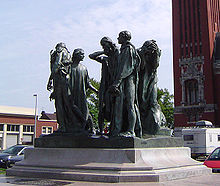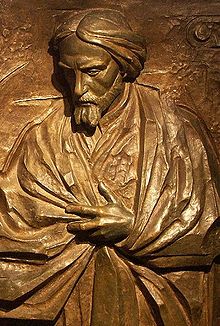Modern Classicism
Modern Classicism contrasted in many ways with the classical sculpture of the 19th century which was characterized by commitments to naturalism (Antoine-Louis Barye) -- the melodramatic (François Rude) sentimentality (Jean Baptiste Carpeaux)-- or a kind of stately grandiosity (Lord Leighton) Several different directions in the classical tradition were taken as the century turned, but the study of the live model and the post-Renaissance tradition was still fundamental to them.
Rodin's The Burghers of Calais in Calais,France.
Auguste Rodin was the most renowned European sculptor of the early 20th century. He is often considered a sculptural Impressionist, as are his students Camille Claudel, Medardo Rosso, Paolo Troubetzkoy, Rik Wouters, and Hugo Rheinhold, attempting to model of a fleeting moment of ordinary life.
Fragment of the grave of Cyprian Kamil Norwid in the Bards' crypt in Wawel Cathedral, Kraków by sculptor Czesław Dźwigaj
Modern Classicism showed a lesser interest in naturalism and a greater interest in formal stylization. Greater attention was paid to the rhythms of volumes and spaces - as well as greater attention to the contrasting qualities of surface (open, closed, planar, broken etc) while less attention was paid to story-telling and convincing details of anatomy or costume. Greater attention was given to psychological effect than to physical realism. Greater attention was given to showing what was eternal and public, rather than what was momentary and private. Greater attention was given to examples of ancient and Medieval sacred arts:Egyptian, Middle Eastern, Asian, African, and Meso-American. Grandiosity was still a concern, but in a broader, more worldwide context.
Sculpture on the Discoveries Age andPortuguese navigators in Lisbon, Portugal
Early masters of modern classicism included: Aristide Maillol, Alexander Matveyev, Joseph Bernard,Antoine Bourdelle, Georg Kolbe, Libero Andreotti, Gustav Vigeland, Jan Stursa, Constantin Brancusi.
As the century progressed, modern classicism was adopted as the national style of the two great European totalitarian empires: Nazi Germany and Soviet Russia, who co-opted the work of earlier artists such as Kolbe and Wilhelm Lehmbruck in Germany and Matveyev in Russia. Nazi Germany had a 12-year run; but over the 70 years of the USSR, new generations of sculptors were trained and chosen within their system, and a distinct style, socialist realism, developed, that returned to the 19th century's emphasis on melodrama and naturalism.
Classical training was rooted out of art education in Western Europe (and the Americas) by 1970 and the classical variants of the 20th century were marginalized in the history of modernism. But classicism continued as the foundation of art education in the Soviet academies until 1990, providing a foundation for expressive figurative art throughout eastern Europe and parts of the Middle East. By the year 2000, the European classical tradition maintains a wide appeal to viewers - especially tourists - and especially for the ancient, Renaissance, Baroque, and 19th century periods—but awaits an educational tradition to revive its contemporary development.
In the rest of Europe, and the United States the modern classical became either more decorative/art deco (Paul Manship, Jose de Creeft, Carl Milles) or more abstractly stylized or more expressive (and Gothic) (Anton Hanak, Wilhelm Lehmbruck, Ernst Barlach, Arturo Martini) -- or turned more to the Renaissance (Giacomo Manzù, Venanzo Crocetti) or stayed the same (Charles Despiau, Marcel Gimond).








0 comments:
Post a Comment
If U like this post then give me a comments about this post